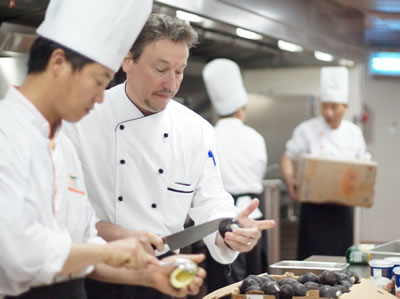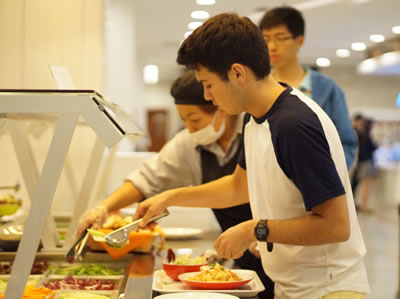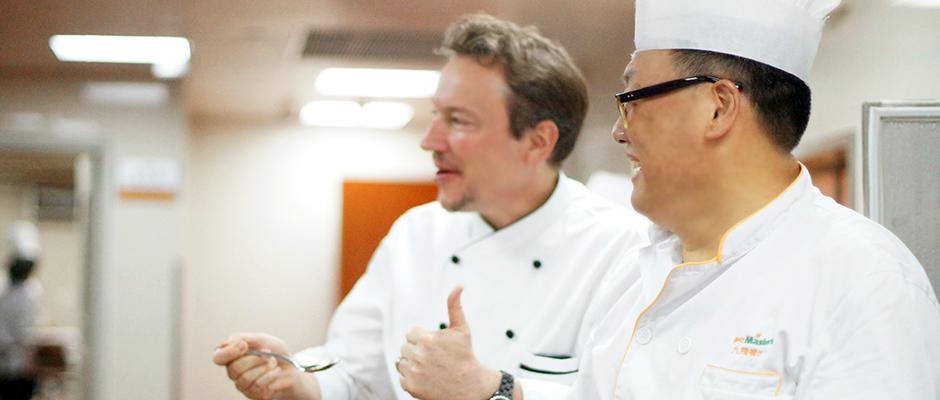“To the people, food is heaven. 民以食为天。”
—Ancient Chinese proverb
Accommodating customers from all over the globe, a university’s international cafeteria has its challenges cut out for it. Recognizing certain shortcomings, and striving to improve existing conditions has pushed the Cafeteria at NYU Shanghai to undergo tremendous transformation. Their objective? To satisfy the demands for better tasting, better quality, and health-conscious foods in order to reflect a variety of cultural appetites and dietary needs.
Kitchen improvements led by Director of Campus & Facilities, David Yen, and administrative staff-turned-chef Associate Director Keith Kraughto entail adding a bevy of kitchen equipment to improve efficiency: immersion blenders, can openers, juicers, cheese graters, deep fryers, meat grinders, a French fry warmer, smoothie blenders, toasters, Panini grills and microwave ovens. The addition of these essential kitchen tools and appliances help reduce food prep time, cutting down on injuries, and allowing more time for the whole group to manage quality control, inspections and thoughtful preparation and cooking.
With recipes in hand, Kraughto walks the team through the selection of ingredients, demonstrating technique, cooking, portions and plating, presentation and proper methods of service. Every step of the way, those involved in the cooking process are guided through taste tests to develop their palate range, and for better understanding and explanation of what is being served to their diners.
In time, the kitchen team has increasingly become familiar with the various forms of seasonings, pastas, sauces, cheeses, vegetables, meats, seafood, etc. and have found channels for procuring products to ensure the consistent supply of quality ingredients.


Kraughto has also enforced the utilization of fresh ingredients, prepared daily, often from "scratch." One such addition has been the wholesome, from-scratch mango, cappuccino, banana, chocolate and orange zest puddings made with care by the pastry chef.
For the campus’ “Western” side of the kitchen, stove burners, soup kettle, broilers, teppanyaki-style flat griddle, heat ovens, and barbecue grill stations join the family of appliances to complement the fully utilized “Chinese” side of the kitchen replete with steamers and woks.
With the kitchen team picking up various kitchen techniques such as knife work, seasoning, sautéing, broiling, grilling, and boiling, a better quality and variety of dishes are emerging from the kitchen and onto the plates of an increasingly delighted dining public. Flavor profiles increasingly represent cuisines worldwide including Mexico, Germany, Japan, Poland, Korea, Russia, Italy, USA, South America, France and the Mediterranean.
Improved communication with kitchen staff and with the dining community is another key component to recent developments. In a fast-paced working environment, the team make effective use of basic sign and body language in the kitchen, mutually learning from each other and growing as a crew over the months. As Kraughto broadens his Chinese lexicon of ingredients, he expresses gratitude towards his team’s willingness to use English. It’s a true team effort with Senior Associate Laura Wang also providing with translation and communication help while Campus Operation Coordinator Rummy Gui, manages the daily material purchases.
For the NYU Shanghai community, weekly menu sharing and daily menu "highlights" are thoughtfully provided, often with cultural and historical elements describing the origin of dishes.
Dishes like Babaganoush—a roasted eggplant dish—are highlighted to celebrate the rich history of world cuisine. Not only can one sample it for the first time at lunch, but also learn from which countries the dish is enjoyed and even specifically where the name originated from. Hint: with an Arabic origin, Babaganoush means “pampered papa.”
The expanded offering of vegetarian and vegan dishes to the daily menu has been another pivotal moment in the culinary transformation of NYU Shanghai’s dining services. Those with restrictive diets, religious or cultural preferences, vegetarian and vegan diets, and health and environmentally conscious members of the community are taken into account.
At each station – Chinese, Western, Halal, Sandwich, and Salad Bar, there has been an integration of vegetable protein, animal product-free dishes, and vegetarian alternatives to meat and fish dishes.
In the spirit of Ally Week and in collaboration with NYU Shanghai’s Animal Rights & Herbivores Society, dishes like creamy tofu “ricotta cheese” pizza and garlic tofu “chicken” pizza have made the dining highlights to deepen the community awareness and appreciation of vegan and vegetarian options.
Kraughto finds it imperative to avidly interact with diners in order to gauge preferences, likes and dislikes—maintaining an open discourse about food and the mutual culinary journey.
It is after reaching out to diners for honest feedback that iced beverages such as lemonade, café au lait, iced tea and coffee joined the regular line up of beverages. Dining trends and feedback are also responsible for entrees such as Hawaiian-style Kalua Pig (smoked pork) with cabbage and rice, Thai-style coconut chicken curry, Mediterranean-inspired shrimp scampi with pasta reappearing on the menu.
The future for dining services at NYU Shanghai looks bright as the dining services team will continually strive to improve their recipes, menus, and service to exceed the expectations of the University community.
Article & Photos by: Charlotte San Juan


